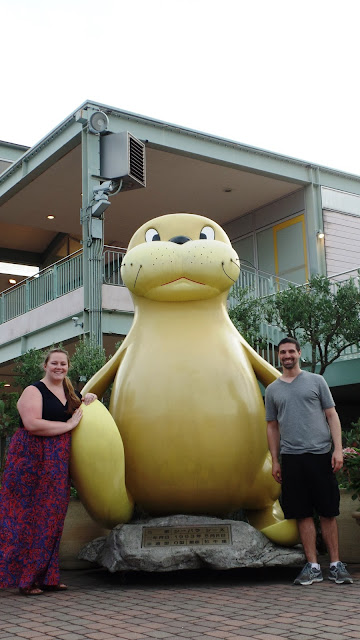I was kind of glad that I woke up to rain this Sunday morning. It meant a mostly inside day, and a chance to rest my poor feet. We did borrow some umbrellas from the hotel, then take a train in to Tokyo. Our goal was to check out Shinjuku Gyoen National Garden, eat some wagyu beef, and buy a suitcase.
The Shinjuku National Garden is a huge park inside the city that features a traditional Japanese garden, a French formal garden, and English landscape garden. We thought the rain was letting up, but when we got to the park it started to pour! We were only able to explore the Japanese garden and the greenhouse, but it was all very beautiful.
After our rainy garden tour, we were hungry! Before we ever even dreamed about coming to Japan, both Ethan and I wanted to try Kobe beef. A lot of places in the US say that they serve real Kobe beef, but in reality, unless you feel like you need to take a mortgage out on your dinner, it's not real Kobe. Or even real wagyu for that matter. That's because Japan exports a very small quantity of this beef and it's actually not best served as a steak! We always assumed Kobe was the best. Turns out that that is not necessarily true. Kobe is a region that in Japan that is famous for their impeccable cattle, but wagyu beef is the type of beef raised from a specific breed of cow. That's what is advertised as "Kobe" beef in Japan. Basically, you're confused America.
What makes the meat so special is the intense marbling throughout it. The cows are bred for their fat content, and are fed special diets to ensure the best quality meat. Rather than being served in steak form, the meat is typically served raw in the size of a credit card. The meat is then grilled immediately before consumption. These types of restaurants are called yakiniku.
Hot briquettes are placed in a cast iron bowl with a grill placed on top. Raw meats are then provided for the patron to grill to their own liking.
For the love of God was this the most delicious thing I have ever in my life put in my mouth.
After our amazing, life changing, totally awesome lunch, the rains stopped. And we explored Shinjuku. I think we stumbled into some kind of red light district. There were sketchy basement entrances with scantily dressed people calling you in. And then there were all of the billboards advertising different types of girls. Idk if they were strip clubs, actual prostitutes, or just porn shops, but it was weird and uncomfortable.
But shopping in Shinjuku was great. Totally awesome and weird at the same time. Seems to sum up a lot of Tokyo. We were able to get a suitcase (one of ours was overweight on the way in) and some cool souvenirs to bring home, like speakers that light up and shoot water to the beat of the music. I thought about buying a little doggie kimono for Penny, but it was actually pretty expensive!





















































